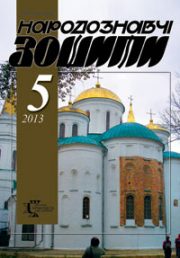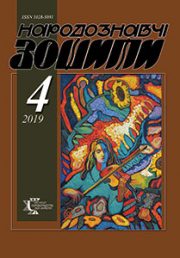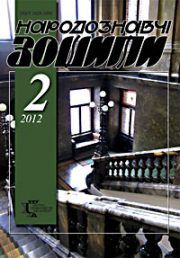The Ethnology Notebooks. 2020. # 6 (156), 1356—1366
УДК 801.631.5:398.8:041(100)
DOI https://doi.org/10.15407/nz2020.06.1356
Halyna KOVAL
- ORCID ID: https://orcid.org/0000-0002-2998-2357
- Candidate of Philological Sciences (PhD),
- Senior Researcher at Folklore Department
- at the Ethnology Institute
- of the National Academy of Sciences of Ukraine
- 15, Svobody Avenue, 79000, Lviv, Ukraine,
- e-mail: galyna.kov@gmail.com
FORMULAICITY IS A UNIVERSAL REGULARITY OF CALENDAR AND RITUAL LITERATURE
One of the basic folklore elements is formulaicity — stereotypes of linguistic and semantic constructions, which in one way or another are embedded in the poetic canon. The researchers use different ways to nominate these stable repeated elements: «formulas», «fixed phrases», «themes», «motives», «loci communes», «traditional epithets», «comparisons», «metaphors», «parallelisms», «idioms», «stable verbal complexes», «blocks».
The aim of the article is to study formulaicity as one of the typological universals of different folklore genres. According to the compositional role, their place in the text, there are introductory or initial formulas, which contain chronological instructions, spatial parameters. These are stable rhythmic verbal constructions which are characterized by recognizability and stereotipicity. They perform memory (mnemonic), utilitarian and aesthetic functions. An important point is that the formulas condense the traditional information that is inherent in different genres of folk works, so it is important to research how the formulas «fit» at the level of the text, how they are motivated, «fitting» into its structure. The article reveals semantic and functional spectrum of formulaicity: they can consolidate significant ritual-based and meaning determining segments of the text, contribute to better preservation of content. They also appear as a result of a creative search for aesthetics, a perfect form, stimulated by faith in the ritual and magical power of the word. They can be called aesthetic markers which determine the folk style of genres. Calendar and ritual songs have their own verbal and poetic and emotional and psychological peculiarities: koliadky and shchedrivky (Christmas carols), songs of praise, vesniankas and hayivkas (folk songs celebrating spring), songs sung during the week prior Pentecost and week after this, petrivka songs (songs sung during St. Peter and St. Paul’s fasting period), songs performed on St. John the Baptist’s Day and obzhynky (harvest festival songs).
The object of the research are types of formulas — medial, which are the key elements of the compositional structure emphasizing the dignity of the master, strength, beauty, request-formulas, warning formulas, formulas of the impossible. To finale formulas belong formulas-wishes aimed at ensuring good harvest, health and well-being of a person. They often have imperative form.
Thus, formulas are the main binding element of a folklore text that often has a projective function, and also performs the function of connecting the text to tradition in a complex universe of folk ideas and ideals, which, in fact, forms the content of traditional folklore text (special folklore reality with its own aesthetic parameters, based on compliance with the norm, the ideal).
Keywords: formulaicity, calendar and ritual; folklore, tradition, poetics.
REFERENCES
- Lord, A. (1975). O formule. Literatura ludowa (Vol. 4—5, pp. 58—64). Wroclaw [in Polish].
- Kolessa, F. (1937). Formulas of endings in Ukrainian folk thoughts. NTSh notes (Vol. 155, pp. 32—33). Lviv [in Ukrainian].
- Maltsev, G. (1989). Traditional formulas of non-ritual lyrics. To the study of the aesthetics of the oral poetic canon. Russian folklore. Poetics of Russian folklore (Vol. 21, p. 28). Moscow [in Russian].
- Kopanytsia, L. (2000). The formulaic motive is a poetic translation of the archetype. Literature. Folklore. Problems of poetics (Vol. 7, p. 156). Kyiv [in Ukrainian].
- Pastukh, N. (2018). Formality in folklore. Ukrainian folklore encyclopedia (P. 734). Lviv [in Ukrainian].
- Dej, O. (Eds.). (1974). Ukrainian folk songs in the records of Zorian Dolenga-Khodakovsky (from Galicia, Volhynia, Podillya, Prydniprianshchyna and Polissya) (P. 119). Kyiv: Naukova Dumka [in Ukrainian].
- Sokil, V., & Sokil, G. (1998). Folklore materials from the fatherland (Pp. 39, 41, 97). Lviv: Institute of Ethnology of the National Academy of Sciences of Ukraine [in Ukrainian].
- Koval, G. (2006). The Virgin in Ukrainian folklore (P. 67). Lviv [in Ukrainian].
- Mishanich, S. (Eds.). (1976). Songs of Podillya. Records of Nastya Prysyazhnyuk in the village of Pohrebyshche. 1920—1970 (P. 113). Kyiv: Naukova Dumka [in Ukrainian].
- Dej, O., & Humeniuk, A. (Eds.). (1963). Games and songs Spring-summer poetry of the working year (P. 126). Kyiv: Naukova Dumka [in Ukrainian].
- Vinogradova, L. (1982). Winter calendar poetry of the western and eastern Slavs. Genesis and typology of caroling (P. 80). Moscow: Nauka [in Russian].
- Hnatyuk, V. (1914). Carols and Christmas carols. Ethnographic collection (Vol. 1, p. 25). Lviv [in Ukrainian].
- Kolessa, F. (1970). Rhythmics of Ukrainian folk songs. Musicological works (P. 82). Kyiv: Naukova Dumka [in Ukrainian].
- Hnatyuk, V. (1909). Gaivki. Materials on Ukrainian ethnology (Vol. 12, pp. 36, 116, 171). Lviv [in Ukrainian].
- Kruk, I. (1993). Medial formula. East Slavic folklore. Dictionary of scientific and folk terminology (P 423). Minsk: Science and Technology [in Byelorussian].
- Shalata, M. (Eds.). (1983). Folk songs in the records of Ivan Vahylevych (P. 26). Kyiv: Musical Ukraine [in Ukrainian].
- Gotting, F. Das Volkslied. Handbuch der Deutschen Volkskunde. Potsdam [s. a.] (P. 372) [in Polish].
- Lord, A. (1994). Narrator (P. 61). Moscow: Vostochnaya literatura RAN [in Russian].
- Bartminsky, E. (2005). Linguistic image of the world: essays on ethnolinguistics (P. 406). Moscow [in Russian].
- Lyashuk, V. Formula. Belarusian folklore. Encyclopedia (Vol. 2, p. 680) [in Byelorussian].
- Reboshapka, I. (1975). The birth of the symbol. Aspects of interaction of rite and ritual poetry (P. 45). Bucharest: Criterion [in Ukrainian].
- Sharaya, O. The formula of the impossible. East Slavic folklore. Dictionary of scientific and folk terminology (P. 424) [in Russian].
- Bogatyrev, P. (1962). The formula of the impossible in Slavic folklore. Slavic philological collection (Vol. 9, p. 362). Ufa [in Russian].
- Kirdan, B. (1983). The formula of the «impossible» in Slavic songs of the Carpathian zone. IX International Congress of Slavists. History, culture, ethnography and folklore of the Slavic peoples (P. 216). Moscow [in Russian].
- Sokil, V. (2020). Boyko folk songs (Vol. 1, p. 37). Lviv [in Ukrainian].
- Veselovsky, A. (1989). Three chapters from historical poetics. Historical poetics (P. 289). Moscow: Higher School [in Russian].
- Shukhevich, V. (1999). Hutsul region. 2nd type (Vol. 4, p. 32). Verkhovina [in Ukrainian].
- Tolstoya, S. (2012). Miracle. Slavic antiquities. Ethnolinguistic dictionary (Vol. 5, p. 558). Moscow [in Russian].
- Hrushevsky, M. (1993). History of Ukrainian literature (Vol. 1, p. 197). Kyiv: Lybid [in Ukrainian].
- Kylymnyk, S. (1994). Ukrainian year in historical light (Book 2, p. 88). Kyiv [in Ukrainian].
- Verkhratsky, I. (1902). On the speech of the Galician Lemkos. Collection of philological section of NTSh (Vol. 5, p. 285). Lviv [in Ukrainian].
- Stupnytsky, V. (2007). Songs of Slobidska Ukraine (P. 17). Kharkiv: Maidan [in Ukrainian].
- Chebanyuk, Yu. (Eds.). (1987). Calendar-ritual songs (P. 334). Kyiv: Dnipro [in Ukrainian].
- (1995). Oh, God, wait for the year of the Bush. Bush songs recorded in Rivne Polissya by Viktor Kovalchuk (P. 9). Rivne [in Ukrainian].
- (1978). Folk songs of Galician and Hungarian Russia, collected by J.F. Golovatsky (Vol. 2, p. 246). Moscow [in Russian].
- (1872). Proceedings of an ethnographic and statistical expedition to the Western Russian Territory equipped with the Imperial Russian Geographical Society. Southwest Department. Materials and research, collection. P.P Chubinsky (Vol. 3, p. 315). St. Petersburg [in Russian].







